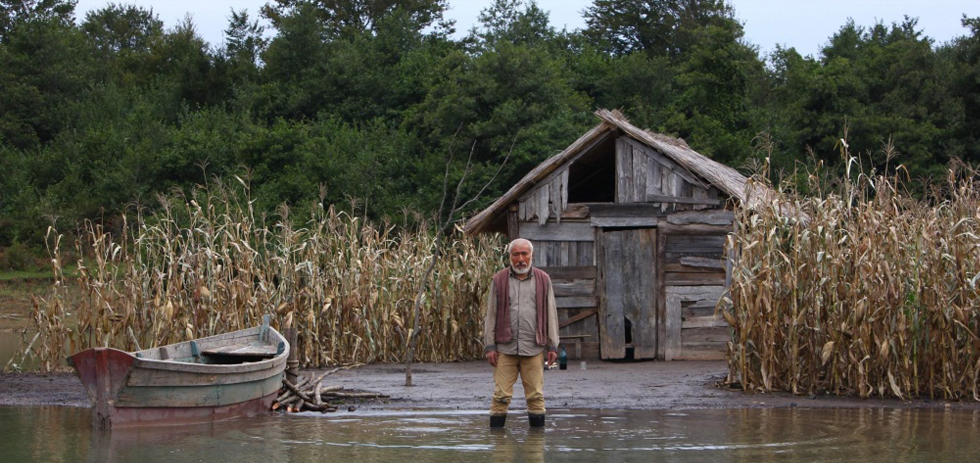
The Inguri River cleaves two nations, Georgia and Abkhazia from each other. It is a border-space in Georgian director George Ovashvili’s Corn Island, both for these two once-warring states, and for a grandfather and granddaughter (wonderful performances from Ilyas Salman and Mariam Buturishvili respectively) who farm one of the tiny islands that are made – and then taken – by the currents of the river. For them, the corn-crop they will grow is a border between subsistence and starvation; the harvest is the swatch of time between her childhood and adolescence; and the island itself becomes the point of intersection between their modest constructions and the untempered forces of nature.
Their labour on the island is ostensibly the entirety of the film, but it is the complexity in both the characters and the cinematography that stops this from becoming condescension or reduction. They build: the wooden walls of their temporary one-room house, then the dams and fencing that anchors the island with hand-sharpened stakes. They til the soil, sow the corn, and we watch as the crop turns from green to yellow, from sprouts to a thick forest of stalks, and then into a brittle and pale maturity. Their patient, companionable work is periodically interrupted by soldiers, who patrol the river – machine guns ever-visible – or loiter on the bank, ogling the granddaughter.
As the stalks lengthen, an injured soldier enters the insularity of the island. He is a little in need of care but more so in need of their complicity in hiding him from his former peers, who come hunting for him. The presence of a stranger is arguably the sole narrative complication in the film. A brief moment of playfulness between the alien soldier and the granddaughter, witnessed stonily by the grandfather, provokes the only flare of tension between them. Later, the solider disappears with as little explanation as he arrived, which leaves the duo to face the powerful climax alone.
Nature and humanity announce themselves as the thematic duality of Corn Island, which is a film that luxuriates in its own cinematic detail and the near-absence of dialogue. Scene after scene unfolds wordlessly without faltering, carried instead by the momentum of the minute: the slow crunch of soil underneath a boot; the glint of light on smooth rolling water; rubbing salt into freshly gutted fish; a glance of narrowed eyes or a shrug, as grandfather and granddaughter farm the tiny, temporary island together for a single season.
The colours change with both season and atmosphere. Lush green as the camera lingers on leaves streamed through by sunlight; yellow, when golden sunlight traces the edge of a cheek or stretches over the corn; a dramatic shift, nearly into greyscale, as a final storm besets the island. Fluid tracking shots (courtesy of Hungarian d.o.p. Elemer Ragalyi) are integrated with the environment beautifully and at times it seems as if the river current moves camera. The low, horizontal angles taken when spades or boots hit soil, or the delightfully balanced framing of the island shot from above are how the cinematography delivers the richness needed to sustain a film so sparse in dialogue and plot.
Violence and mercy, however, are another set of twinned themes, splitting both nature and humanity between themselves (if it seems dubious to attribute mercy to nature, I can only refer us back to the film, which draws the metaphor itself). The brutalities of nature and of war are never grossly explicated by the camera, which makes the intensity of their presence a remarkable testament to the filmmaking. They are defined with subtlety, often by implication or by sound but always without unnecessary gore or aestheticised suffering. There is, perhaps, space in Corn Island for greater emotional ambivalence or articulation, and violence and mercy might lend themselves to slightly more complexity, rather than less. Though the lack of dialogue never undoes the film, it might have benefited from even a handful of additional lines: not to say what doesn’t need to be said but to explore an emotional or political aspect that often remains inchoate.
Gunshots rip through the air but are never seen. The belligerent masculinity of the anonymous soldiers, who repeatedly eye off the granddaughter, is tense and unsettling: the threat of sexual violence is never realised but always present. So, too, is the broader history of war in which this threat is included. The absence of the generation between grandfather and granddaughter is never explained, although their death is inferred – but the grandfather reluctantly keeps a gun to hand, and the granddaughters eyes tighten when she realises the soldiers are Georgian.
In some respects, Corn Island is an unintentional defense of theatre-going: both the soundscape and the cinematography can only be fully realised in the cinema. The depth of sound that is usually only available in a cinema is needed to round out the visual of an oar pushing through water or a plank of wood rocking over a stone. Corn Island is an immersive, powerful experience. Its slowness is meditative rather than tedious, and patience from the audience is justified over and over again by the stunning visuals, rich soundscape and emotional nuance. For any viewer who remained dubious throughout, the conclusion dramatically reasserts the power of the film. It is a devastating finale, reminding an audience of their emotional investment in the film by shattering it.
